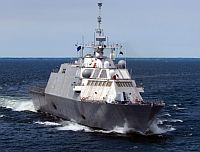 In March of this year, we posted about the repeated blackouts suffered on the USS Freedom as it made its way to a deployment in Singapore. Recently the ship was delayed due to failures in its water jet controls. In October it was sidelined by failures in the hydraulic systems. In July, the ship had generator and coolant system problems. In addition to the problems with the mechanical and control systems, the ship has suffered repeated hull cracking, which have limited speeds.
In March of this year, we posted about the repeated blackouts suffered on the USS Freedom as it made its way to a deployment in Singapore. Recently the ship was delayed due to failures in its water jet controls. In October it was sidelined by failures in the hydraulic systems. In July, the ship had generator and coolant system problems. In addition to the problems with the mechanical and control systems, the ship has suffered repeated hull cracking, which have limited speeds.
USS Freedom is the first of one of two designs of the U.S. Navy’s Littoral Combat Ships. A recent GAO report has also questioned whether the LCS ships’ communications systems are adequate for the networked missions intended. A report from earlier this year suggested that the LCS may nor be survivable in combat.
The LCS are intended as agile coastal patrol craft designed for anti-mine warfare, anti-submarine warfare, and surface warfare missions; as well as humanitarian relief. The Navy has planned on ordering 52 of the vessels for $40 billion. Given budgetary concerns, project cost overruns and questions of reliability, Defense Department budget planners have suggested that the Navy buy as few as 32 of the vessels.

more wasted government money. the sooner they axe the program, the better.
Just like any other Class leader, nothing new in the navy, first in the class always has problems to get worked out.
I read someplace (Proceedings magazine I believe) that a better, and cheaper, LCS solution would to bring back an updated version of the Oliver Hazard Perry frigate. The idea was to lengthen the hull 25-30′ for accommodations and equipment and you’re pretty much go to go.
At least the FFG is a known commodity and the drawings still exist.
Now I don’t pretend to know what the Navy is looking for but I do think that if you have to build two separate models of something to find out which is better than you probably haven’t given much thought to which problem you’re trying to solve.
I suspect that you are right. When Hagel ordered the Navy report to develop potential ship options that would be “generally consistent with the capabilities of a frigate,” that may have been exactly what he was asking for.